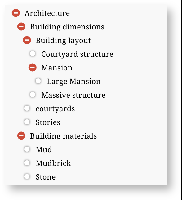You can browse trees by clicking the Search icon (
Knowledge Maps let you build semantic fields or ontologies of terms, which you can then use to label resources you create in Mandala. At the most basic level, Knowledge Maps are terms or tags built hierarchically. This places a term in the appropriate context. There are currently two types of Knowledge Maps: subjects and places. We call the hierarchical grouping of terms a Knowledge Map tree.
Subject and places are built collaboratively, through crowd-sourcing. Ideally, new subjects or places should integrate into the existing trees at https://mandala.shanti.virginia.edu/subjects and https://mandala.shanti.virginia.edu/places. We understand that everyone has different needs for their project, and are happy to implement whatever terms most serve your scholarship. In return, we ask that you come to meetings open to collaboration and productive conversation.
The first step in adding new Knowledge Maps terms is to email the Mandala team at shanti@virginia.edu. We'll set up a meeting to discuss your project.
This guide helps you prepare for your first Knowledge Maps discussion.
Here are some tips for building subject trees:
Make sure your terms can stand alone. While context within the tree enhances subject terms, there are some places within Mandala where terms won't be shown within the tree. Avoiding vague terms like "yes" or "no" make your terms easier to find and use.
|
|
|---|---|
|
|
You should think about whether your places are administrative (ie, the official state of Virginia) or cultural (ie, the Rotunda). These will have different implementations in Places.

Knowledge Map hierarchies in Mandala are built with tree data structures. Each knowledge map term is a node on the tree. You can place a knowledge map term using its parent — that is, the higher-level term the knowledge map falls under. Nodes that fall under a parent are its children. If a node doesn’t have a parent — that is, it’s the highest possible level of the tree – we call it the root node. A node may have many children, but it only has one the parent. In the example above:
To format your tree in a spreadsheet, every row represents a node. In the first column, write the node's name. In the second, write the name of the node's parent. If the node is a root, the parent will be blank. Make sure you use consistent names, with consistent capitalization. Here's a table for the sample tree:
| Node | Parent |
|---|---|
| Architecture | |
| Building dimensions | Architecture |
| Building materials | Architecture |
| Building layout | Building dimension |
| Courtyard structure | Building layout |
| Mansion | Building layout |
| Large Mansion | Mansion |
| Massive structure | Building layout |
| courtyards | Building dimensions |
| Stories | Building dimensions |
| Mud | Building materials |
| Mudbrick | Building materials |
| Stone | Building materials |
This spreadsheet will help developers import your terms quickly.
Once you have added a new set of terms to a tree, we hope you'll become the "owner" for that node. That means you can add and delete any children for which that node is a parent. As the node owner, you can let collaborators add children to that term.
The timeline will vary. Places may take longer to add than subjects, especially if you need accurate administrative data. In these cases, adding places may take as long as a month. In your meeting, the Knowledge Maps team can give you more accurate time estimates based on your specific needs. Needless to say, you should start the process well before any deadlines.